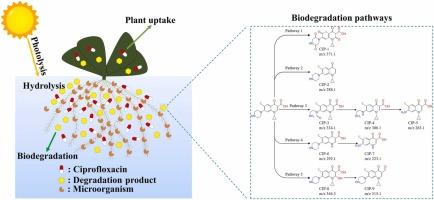盐肤木修复被环丙沙星污染的水体的潜力:去除、生理反应和根部微生物群落
IF 12.2
1区 环境科学与生态学
Q1 ENGINEERING, ENVIRONMENTAL
引用次数: 0
摘要
本文研究了双叶沙参(Salvinia biloba Raddi)在不同条件下对环丙沙星(CIP)的去除量、不同浓度CIP下的生理反应、CIP对双叶沙参根系微生物群落结构的影响、可能的代谢途径及去除机制。结果表明,在 4 mg/L CIP 条件下,CIP 的去除率为 98%。在不同的 CIP 浓度条件下,低浓度 CIP 会促进双叶小檗的生长,而高浓度 CIP 则会抑制双叶小檗的生长,并且双叶小檗会受到不同程度的氧化胁迫。CIP 影响了根系微生物群落的多样性,改变了微生物群落结构。通过测定中间代谢物,提出了五种可能的降解途径。根据质量平衡计算,生物降解是最关键的降解途径。这项研究证明了双叶木贼在处理 CIP 污染水方面的潜在用途,并提供了对植物抗生素降解机制的见解。本文章由计算机程序翻译,如有差异,请以英文原文为准。

Potential of Salvinia biloba Raddi for the remediation of water polluted with ciprofloxacin: removal, physiological response, and root microbial community
This paper investigated the removal amount of Ciprofloxacin (CIP) by Salvinia biloba Raddi (S. biloba) under various conditions, the physiological response under different CIP concentrations, the influence of CIP on the root microbial community structure of S. biloba, the possible metabolic pathways and removal mechanism. The results showed that under 4 mg/L CIP, the removal rate of CIP was 98%. Under different CIP concentration conditions, low CIP concentration promoted the growth of S. biloba, while high CIP inhibited the growth of S. biloba and S. biloba was exposed to different degrees of oxidative stress. CIP affected root microbial community diversity and changed microbial community structure. Five possible degradation pathways were proposed through the determination of intermediate metabolites. According to mass balance calculations, biodegradation was the most critical degradation pathway. This study demonstrated the potential use of S. biloba for treating CIP-contaminated water and provided insights into the mechanisms of plant-based antibiotic degradation.
求助全文
通过发布文献求助,成功后即可免费获取论文全文。
去求助
来源期刊

Journal of Hazardous Materials
工程技术-工程:环境
CiteScore
25.40
自引率
5.90%
发文量
3059
审稿时长
58 days
期刊介绍:
The Journal of Hazardous Materials serves as a global platform for promoting cutting-edge research in the field of Environmental Science and Engineering. Our publication features a wide range of articles, including full-length research papers, review articles, and perspectives, with the aim of enhancing our understanding of the dangers and risks associated with various materials concerning public health and the environment. It is important to note that the term "environmental contaminants" refers specifically to substances that pose hazardous effects through contamination, while excluding those that do not have such impacts on the environment or human health. Moreover, we emphasize the distinction between wastes and hazardous materials in order to provide further clarity on the scope of the journal. We have a keen interest in exploring specific compounds and microbial agents that have adverse effects on the environment.
 求助内容:
求助内容: 应助结果提醒方式:
应助结果提醒方式:


